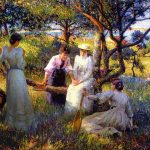Robert Lewis Reid (1862–1929) was an American artist known for his contributions to the American Impressionist movement. Born in Stockbridge, Massachusetts, Reid’s artistic journey began at a young age, leading him to study at the prestigious School of the Museum of Fine Arts, Boston, and later at the Art Students League in New York. His quest for artistic growth took him to Paris, where he studied under renowned artists at the Académie Julian, a common practice among American artists seeking to refine their skills and absorb European influences during the late 19th century.
Reid’s early work was marked by the influence of his European training, particularly the academic realism prevalent in Parisian art schools at the time. However, upon returning to the United States, Reid’s style evolved, reflecting the lighter palette, looser brushwork, and interest in capturing the effects of light characteristic of Impressionism. This shift was partly influenced by the changing dynamics of the American art scene and the growing popularity of Impressionism among American artists and collectors.
Throughout his career, Reid became known for his decorative murals, portraits, and landscapes. His murals, which adorn several notable public buildings, including the Library of Congress in Washington, D.C., and the Appellate Court House in New York City, are celebrated for their vibrancy and the incorporation of allegorical themes. These works demonstrate Reid’s ability to blend the aesthetic principles of Impressionism with the demands of large-scale decorative art, showcasing his versatility as an artist.
Reid was also a prominent figure in the Ten American Painters, a group of American Impressionists who sought to break away from the traditional constraints of the art establishment. By organizing their exhibitions, the group played a crucial role in promoting Impressionism in the United States, challenging the dominance of academic painting and introducing American audiences to a new way of seeing and depicting the world.
Reid’s contribution to American art extends beyond his murals and involvement with the Ten American Painters. His portraits and landscapes, often characterized by their vibrant colors, delicate handling of light, and intimate portrayal of subjects, reflect his mastery of the Impressionist style. Reid had a particular talent for capturing the transient effects of light on surfaces, a hallmark of Impressionist painting, which he applied not only to landscapes but also to the depiction of human figures and interiors.
Despite the prominence of his larger works, Reid’s smaller canvases, where he often explored the beauty of everyday scenes and the natural world, remain equally compelling. These works, with their emphasis on the fleeting moments of light and color, contribute to our understanding of American Impressionism as a movement that sought to capture the essence of the American landscape and the nuances of social life at the turn of the century.
Robert Lewis Reid’s legacy is that of an artist who successfully bridged the gap between the academic traditions of his training and the innovative techniques of Impressionism. His work reflects the broader trends in American art at the turn of the 20th century, a period marked by a search for a distinct American artistic identity amidst the influx of European influences. Reid’s murals, portraits, and landscapes not only exemplify the aesthetic achievements of American Impressionism but also contribute to the cultural narrative of an evolving nation.
Today, Reid’s work is celebrated for its contribution to the American Impressionist movement and its role in shaping the visual landscape of America’s public and private spaces. His paintings continue to be appreciated for their beauty, technical skill, and capacity to evoke the spirit of an era that was pivotal in the development of American art.






